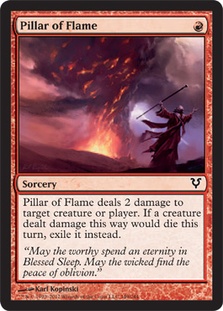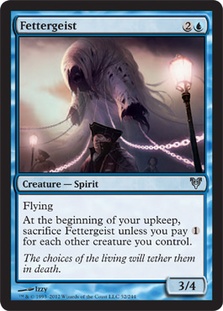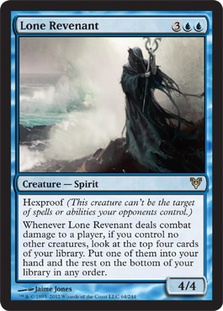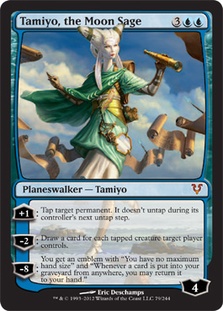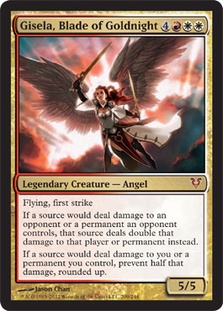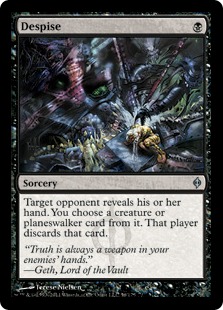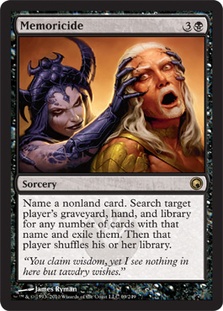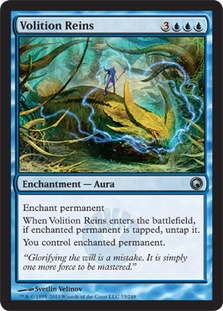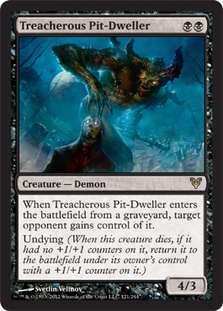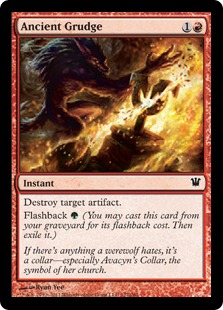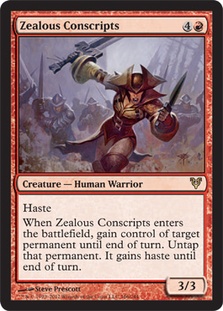In the early days of a new format, we’re all eager for fresh ideas. I’m always surprised, though, at the clamor for decklists, decklists, decklists. The fact is that between restricted testing time and an unsteady metagame, early deck ideas from columnists like me—or even winning lists from the first few weekends—rarely stand the test of time. Their value only comes from their role as starting points; they’re the diving boards from which we start our exploration of the new format. But there are plenty of other ways to stimulate deep thinking and creativity! Today I’m going to try a different approach.
One of the most helpful articles I remember ever reading is "The Best Cards in Extended You Need to Know About" by Ben Hayes. In the early days of the PTQ season, Ben highlighted the cards he felt could be major players in the format. Because his emphasis wasn’t on decklists, his ideas never became outdated, and I found myself returning to his article all season whenever I needed inspiration for a deck or sideboard idea.
With the goal of inspiring the creative deckbuilders and innovators among my readers, I’m going to offer my own list of cards to watch in Standard, with emphasis on the ones that aren’t seeing the play and hype that they deserve.
I may as well begin with the ones that are fresh in my mind coming off of Pro Tour Avacyn Restored. For the Block Constructed portion, I played a W/U/R Control deck courtesy of Patrick Chapin. In his article reflecting on the PT, he expressed disappointment with the deck, but in my opinion he was being too modest. I piloted the deck to a 7-3 record, and I don’t see a reason why I couldn’t go 10-0 if I replayed the tournament with a few sideboard changes.
Creatures (6)
Planeswalkers (3)
Lands (26)
Spells (25)

This deck has a lot of great things going for it, and many of them can be ported to Standard.
Pillar of Flame
At Grand Prix Minneapolis last weekend, Grixis Control was my deck choice. In a field full of Delvers of Secrets, Strangleroot Geists, Gravecrawlers, Geralf’s Messengers, and a dozen other weenies, Pillar of Flame is a brutally efficient control card. Being able to effortlessly clean up the undying creatures from G/R Aggro and Zombies will take away their main weapon against control. Also look for Pillar as another burn option for G/R Aggro and Wolf Run Ramp, as it allows you to minimize the damage from a Solemn Simulacrum that tries to slow your progress.
Fettergeist
Old timers will remember fondly a time when three mana for a 3/4 flier was quite good.
I’ve got news: three mana for a 3/4 flier is good by any standards at any point in Magic’s history! The idea to maindeck Fettergeist was a turning point in the development of the Block control deck, as it provided a brutal roadblock against aggro, a way to pressure opposing planeswalkers, and reduced our vulnerability to Zealous Conscripts.
Fettergeist is difficult to remove and even more difficult to attack through. It forces the beatdown player to overextend, so it combos quite well with sweepers. Unfortunately, in our Block deck we had no alternative to Terminus, but Standard also offers Slagstorm, Whipflare, and Black Sun’s Zenith, which can leave your Fettergeist alive.
In terms of beatdown, Fettergeist is only at its best when your deck has a small number of creatures. Traditionally, that would be a disadvantage, but it just so happens that Delver of Secrets and Snapcaster Mage share the exact same quality! (Though I’ll admit that the competition at the three-drop slot is quite stiff.) I could also see Fettergeist combining with Snapcaster and burn spells to provide valuable aggressive potential to a midrange or controlling deck.
For anyone wondering, there’s no need to announce that you’re paying zero every upkeep if you have no other creatures in play.
Lone Revenant
I questioned Lone Revenant early in our Block testing, arguing that it compared unfavorably to Sigarda, Host of Herons, which is similar and fills the same spot on the mana curve. Patrick explained that while Sigarda is a 5/5, Lone Revenant may as well be a "20/4" and challenged me to count the number of games I lost after connecting with him.
The tally’s at zero and counting.
He ended up only being a one-of in our Block deck, but he certainly pulled his weight and swapping Terminus for sweepers that don’t kill him would only make Lone Revenant dramatically better. Hexproof makes him immune to Zealous Conscripts, Vapor Snag, and Doom Blade, which cements his value as a reliable win condition for control decks. He also happens to fit the mana curve quite well, as he doesn’t compete with the Titans and Consecrated Sphinx and can come down on turn 4 after a Pristine Talisman.
Tamiyo, the Moon Sage
I’m torn about Tamiyo, as she’s a generally excellent card but remarkably terrible against Delver. She’d be at her best in a deck that can ensure her -2 ability is useful (maybe Esper Control with Lingering Souls), but even beyond that, I’d strongly consider her as a sideboard option against Wolf Run and control mirrors.
Gisela, Blade of Goldnight
Gisela is similar to Consecrated Sphinx in the sense that she’s easy for some decks to kill but will always win you the game when she goes unanswered. I see her as particularly devastating against Wolf Run Ramp, as her first strike will let her win a fight against a Titan no matter how much mana they sink into their Kessig Wolf Run. She protects you from being burned out, even by giant Devil’s Plays. In other matchups, she does double duty against Sword of War and Peace, rounding down both the creature’s damage and the extra ability from the Sword.
Seven mana is a lot, but Gisela is on par with Elesh Norn, Grand Cenobite and Karn Liberated for any deck that can support her. Just watch out for Zealous Conscripts!
Covering my Pro Tour Avacyn Restored deck was the easy part. The fact is that Standard control players have a tough new challenge to confront in the form of Cavern of Souls. The Cavern at once revitalized Wolf Run Ramp and took away the simplest way to fight it. While permission is still a useful tool for the matchup, it’s now important to diversify your answers and take a serious approach to fighting Wolf Run on multiple fronts.
Despise
Conveniently, Despise can strip any card that Cavern of Souls can make uncounterable. The old plan of countering everything Wolf Run does for the whole game will no longer work. The new plan should be to resolve the first bomb and then fight them on their own level. Despise fits perfectly into that plan, as you only give them a very narrow window to topdeck on you.
Despise also serves as a preemptive answer to Thrun, the Last Troll and is generally good for disrupting the opponent’s mana curve. The latter is applicable in plenty of non-Wolf Run matchups like Zombies, G/R Aggro, and Humans.
Memoricide
It brings a tear to my eye, remembering what a great team Inquisition of Kozilek, Memoricide, and I used to be. Those cards were a huge part of control’s gameplan against Valakut Ramp, and though Inquisition is gone, Despise can be a good substitute. Granted, Wolf Run’s threats are more diverse than Valakut’s were, but for a control deck Primeval Titan is still the one that matters. Cheap discard or even Gitaxian Probe can help you plan for how to handle their less potent threats (Doom Blade for Inferno Titan, Mana Leak for planeswalkers, etc.), and Memoricide can take out the Primeval Titan, which is the most difficult card to handle profitably.
Karn Liberated
As I mentioned above, my new plan for fighting Wolf Run is to be the first to resolve a bomb, and landing Karn on a clean board will be almost impossible for them to overcome.
More importantly, as Cavern of Souls forces control decks to lean less heavily on permission, trump cards like Karn become more important in control mirrors. It matters little which planeswalkers or Titans my opponent chooses to use, because Karn can go over the top of any of them. I don’t think it’s a stretch to play two Karns in your 75 right now, as you’ll enjoy a tremendous late game advantage in control mirrors.
Volition Reins
Or you could go one step further and play the card that trumps the trump cards. The more control mirrors become tap out battles, the more often the player with a Volition Reins will come out on top. Beyond that, if people adopt Brian Kibler Pro Tour winning technology of two Karns on the Wolf Run sideboard, Volition Reins can be a backbreaking surprise for that matchup as well.
Moving beyond control, there are plenty of beatdown cards that have not yet been properly explored.
Treacherous Pit-Dweller
Black aggro suffers from a frustrating lack of powerful two-drops. I’ve seen all-stars ranging from Porcelain Legionnaire to Blood Artist to Walking Corpse being played in Zombie decks, but I’m convinced you could build a deck where your two-drop need not be your weak link.
If you can overlook his downfall, Treacherous Pit Dweller is a remarkably powerful card in addition to filling a much-needed role. Having access to Vapor Snag could even turn his downfall into a significant upside. Consider this rough sketch:
Creatures (15)
Planeswalkers (2)
Lands (22)
Spells (21)

U/B Delver, particularly with the double-colored Pit-Dweller, would have worse mana than the traditional U/W build. However, without Moorland Haunt, I think it could work out. Liliana of the Veil, in addition to being a generally powerful card that provides an extra angle of attack, would be your insurance against flooding. She would pressure the resources of mana-hungry opponents while you could conveniently discard any land beyond number three or four.
Black provides access to removal without costing you too much life in Phyrexian mana, which would be valuable against aggressive decks and in the pseudo-mirror. Finally, I think the Pit-Dweller himself would be quite impressive in this strategy. Note that losing control of him is an ability that triggers after he comes into play with undying, so copying him with Phantasmal Image is unfairly powerful. You get a 4/3 creature with undying for two mana, and when he comes back, instead of losing control of him, you get to copy whatever other creature is most convenient for you!
Ray of Revelation
Between Silverblade Paladin, Cavern of Souls, and a handful of powerful red humans, Champion of the Parish decks are rightfully gaining in popularity. With them come the powerful enchantments Honor of the Pure and Oblivion Ring. For a few weeks now I’ve been advocating W/G Humans, and Ray of Revelation would be a powerful sideboard card for such a strategy. Imagine being the only one with Honor of the Pure in a mirror match and doing so while gaining card and tempo advantage.
Any deck with access to white and green mana should consider Ray as a sideboard card in small numbers. For a control deck, removing Honors turns on red removal and Curse of Death’s Hold against white weenie, and for control mirrors being able to take out opposing Oblivion Rings and Volition Reins is a powerful tool.
Ancient Grudge
While Ray of Revelation is a useful tool, its cousin, Ancient Grudge, is a powerhouse. Nearly every deck in the format maindecks artifacts and a good portion of them depend on them. Stripping equipment off of creatures and pulverizing mana bases that depend on Sphere of the Suns and Pristine Talisman will lead to many easy wins. Saying that Ancient Grudge can be a maindeck card in this format would be an understatement. If you have red and green mana, I challenge you to have a very good reason not to maindeck at least one Ancient Grudge. Yes, that means you Wolf Run and G/R Aggro players…
Zealous Conscripts
Like Phantasmal Image and Vapor Snag, I feel that Zealous Conscripts will become a format-defining card in the way it restricts which win conditions are playable and which ones are liabilities. Playing the Pro Tour, Conscripts was on my mind at all times. There were games where I stopped using Tamiyo once she hit seven counters and games where I held Gisela in my hand for half a dozen turns for fear of her turning against me.
Zealous Conscripts may be less prevalent in Standard, but its specter is no less terrifying. Don’t build a deck that loses to it. Don’t sculpt a game plan that gets blown out by it. If you’re playing a red deck with any aggressive potential whatsoever, do include Zealous Conscripts in one or two copies.
Somberwald Sage
A few weeks ago, I covered the powerful Green Sun’s Zenith targets from Avacyn Restored, and Somberwald Sage was one of them. After seeing the power of Wolf Run Ramp in the new format and how much Cavern of Souls adds to the strategy, I think Somberwald Sage deserves a second look.
The danger of building around such a card is that you could frequently not draw it or it could be killed. However, there’s enough efficient mana ramping in Standard that playing a deck with Somberwald Sage and lots of six- and seven-drops would be perfectly reasonable. Your creatures aren’t vulnerable to permission because of Cavern of Souls, and you could be bigger and faster than all the other creature decks in the format. Some cards that could deserve a look alongside Somberwald Sage are Gisela, Blade of Goldnight; Elesh Norn, Grand Cenobite; and Vorinclex, Voice of Hunger.
I hope these ideas will inspire you to explore the hidden potential in Standard. In addition to being fringe options for established decks, some of the cards listed above are powerful enough to spawn brand new strategies and change the face of the format.

